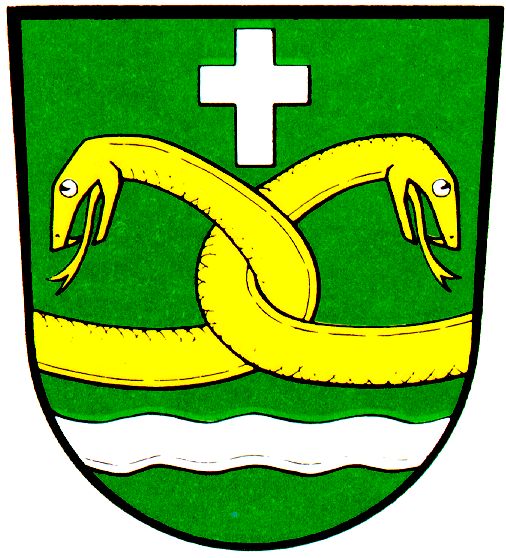Untermerzbach: Difference between revisions
Knorrepoes (talk | contribs) m (Text replacement - "{{de1}}" to "{{de}}") |
Knorrepoes (talk | contribs) m (Text replacement - "|'''English''' ↵| {{blazon wanted}}↵|}" to "|'''English''' | blazon wanted |}") |
||
| Line 17: | Line 17: | ||
|- | |- | ||
|'''English''' | |'''English''' | ||
| | | blazon wanted | ||
|} | |} | ||
Revision as of 12:18, 30 July 2023
UNTERMERZBACH
State : Bayern
District (Kreis) : Hassberge
Additions : 1971 Gereuth, Obermerzbach, Wüstenwelsberg; 1978 Gleusdorf, Memmelsdorf in Unterfranken
| German |
Über einem silbernen Wellenbalken in Grün zwei jeweils aus dem Schildrand hervorbrechende, ineinander verschlungene goldene Schlangen, über denen ein silbernes Kreuz schwebt. |
| English | blazon wanted |
Origin/meaning
Untermerzbach did not have arms until the 1970s. The seal of the municipality showed a tree, symbolising a well-known local tree. When the discussion started to devise new arms, the tree was considered not suitable. On July 9, 1979, the local council decided to adopt new arms. The new arms were adopted on January 21, 1980 and granted on May 12, 1980.
The main symbol, the two snakes, are derived from the door of the oldest church in the municipality, the church of Obermerzbach. The snakes date from the early Middle Ages. The cross is taken as a symbol for the castle in Untermerzbach, where a catholic school and educational institute have been situated for many centuries. The waves in the lower part symbolise the village of Memmelsdorf in the municipality. The waves are also canting for the Merzbach river in the municipality (Bach=brook/river). The actual meaning of the snakes is not known. There have been many discussion on their origin, but there is no agreement on the different meanings proposed.
This page is part of the German heraldry portal Deutsche Wappensammlung |
Heraldry of the World |
|
German heraldry:
|
Selected collector's items from Germany:
|
Literature: Maier, Edgar: Das Untermerzbacher Gemeindewappen, Heimatkundliche Blätter 1/1999, S. 1 ff


